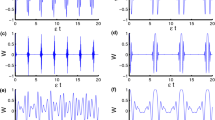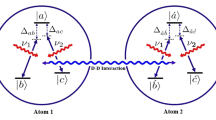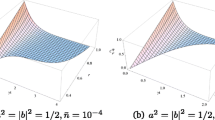Abstract
We study the dynamics of the three-qubit system interacting with multi-mode without rotating wave approximation (RWA). A physical realization of the system without direct qubits interactions with dephasing bath is proposed. It is shown that non-Markovian characters of the purity of the three qubits and the coupling strength of modes are stronger enough the RWA is no longer valid. The influences of the dephasing of qubits and interactions of modes on the dynamics of genuine multipartite entanglement and bipartite correlations of qubits are investigated. The multipartite and bipartite quantum correlations could be generated faster if we increase the coupling strength of modes and the RWA is not valid when the coupling strength is strong enough. The unitary transformations approach adopted here can be extended to other systems such as circuit or cavity quantum electrodynamic systems in the strong coupling regime.








Similar content being viewed by others
References
Agarwal, G.S.: Quantum Optics. Cambridge University Press, Cambridge (2013)
Holstein, T.: Studies of polaron motion: Part I. The molecular-crystal model. Ann. Phys. 8, 325–342 (1959)
Nielsen, M.A., Chuang, I.L.: Quantum Computation and Quantum Information. Cambridge University Press, Cambridge (2000)
Larson, J., Moya-Cessa, H.: Rabi oscillations in a quantum dot-cavity system coupled to a nonzero temperature phonon bath. Phys. Scr. 77, 065704 (2008)
Zhang, J.S., Chen, A.X.: Thermal effects on bipartite and multipartite correlations in fiber coupled cavity arrays. J. Opt. Soc. Am. B 31, 1126–1131 (2014)
Zhang, J.S., Chen, A.X.: Enhancement of genuine multipartite entanglement and purity of three qubits under decoherence via bang–bang pulses with finite period. Quantum Inf. Process. 15, 3257–3271 (2016)
Wu, Y., Yang, X.: Jaynes–Cummings model for a trapped ion in any position of a standing wave. Phys. Rev. Lett. 78, 3086–3088 (1997)
Scully, M., Zubairy, M.S.: Quantum Optics. Cambridge University Press, Cambridge (1997)
McKeever, J., Buck, J.R., Boozer, A.D., Kimble, H.J.: Determination of the number of atoms trapped in an optical cavity. Phys. Rev. Lett. 93, 143601 (2004)
Hennessy, K., Badolato, A., Winger, M., Gerace, D., Atatüre, M., Gulde, S., Fält, S., Hu, E.L., Imamog brevelu, A.: Quantum nature of a strongly coupled single quantum dot-cavity system. Nature (London) 445, 896–899 (2007)
Irish, E.K., Gea-Banacloche, J., Martin, I., Schwab, K.C.: Dynamics of a two-level system strongly coupled to a high-frequency quantum oscillator. Phys. Rev. B 72, 195410 (2005)
Bloch, F., Siegert, A.: Magnetic resonance for nonrotating fields. Phys. Rev. 57, 522–524 (1940)
Lizuain, I., Muga, J.G., Eschner, J.: Vibrational Bloch–Siegert effect in trapped ions. Phys. Rev. A 77, 053817 (2008)
Sornborger, A.T., Cleland, A.N., Geller, M.R.: Superconducting phase qubit coupled to a nanomechanical resonator: beyond the rotating-wave approximation. Phys. Rev. A 70, 052315 (2004)
Zueco, D., Reuther, G.M., Kohler, S., Hanggi, P.: Qubit-oscillator dynamics in the dispersive regime: analytical theory beyond the rotating-wave approximation. Phys. Rev. A 80, 033846 (2009)
Chen, Q.H., Yang, Y., Liu, T., Wang, K.L.: Entanglement dynamics of two independent Jaynes–Cummings atoms without the rotating-wave approximation. Phys. Rev. A 82, 052306 (2010)
Hausinger, J., Grifoni, M.: Qubit-oscillator system: an analytical treatment of the ultrastrong coupling regime. Phys. Rev. A 82, 062320 (2010)
Agarwal, G.S., Rafsanjani, S.M.H., Eberly, J.H.: Tavis-Cummings model beyond the rotating wave approximation: quasidegenerate qubits. Phys. Rev. A 85, 043815 (2012)
Liao, J.Q., Huang, J.F., Tian, L.: Generation of macroscopic Schrödinger-cat states in qubit-oscillator systems. Phys. Rev. A 93, 033853 (2016)
Braak, D.: Integrability of the Rabi model. Phys. Rev. Lett. 107, 100401 (2011)
Cárdenas, P.C., Teixeira, W.S., Semião, F.L.: Non-Markovian qubit dynamics in a circuit-QED setup. Phys. Rev. A 91, 022122 (2015)
Cárdenas, P.C., Teixeira, W.S., Semião, F.L.: Coupled modes locally interacting with qubits: critical assessment of the rotating-wave approximation. Phys. Rev. A 95, 042116 (2017)
Breuer, H.P., Petruccione, F.: The Theory of Open Quantum Systems. Oxford University Press, Oxford (2007)
Barnett, S.M.: Quantum Information. Oxford University Press, New York (2009)
Jungnitsch, B., Moroder, T., Gühne, O.: Taming multiparticle entanglement. Phys. Rev. Lett. 106, 190502 (2011)
Horodecki, R., Horodecki, P., Horodecki, M., Horodecki, K.: Quantum entanglement. Rev. Mod. Phys. 81, 865 (2009)
Wootters, W.K.: Entanglement of formation of an arbitrary state of two qubits. Phys. Rev. Lett. 80, 2245–2248 (1998)
Yu, T., Eberly, J.H.: Finite-time disentanglement via spontaneous emission. Phys. Rev. Lett. 93, 140404 (2004)
Yu, T., Eberly, J.H.: Sudden death of entanglement. Science (London) 323, 598–601 (2009)
Zhang, J.S., Chen, A.X.: Controlling sudden transitions of bipartite quantum correlations under dephasing via dynamical decoupling. J. Phys. B At. Mol. Opt. Phys. 47, 215502 (2014)
Bennett, C.H., DiVincenzo, D.P., Fuchs, C.A., Mor, T., Rains, E., Shor, P.W., Smolin, J.A., Wootters, W.K.: Quantum nonlocality without entanglement. Phys. Rev. A 59, 1070–1091 (1999)
Horodecki, M., Horodecki, P., Horodecki, R., Oppenheim, J., Sen, A., Sen, U., Synak-Radtke, B.: Local versus nonlocal information in quantum-information theory: formalism and phenomena. Phys. Rev. A 71, 062307 (2005)
Niset, J., Cerf, N.J.: Multipartite nonlocality without entanglement in many dimensions. Phys. Rev. A 74, 052103 (2006)
Modi, K., Brodutch, A., Cable, H., Paterek, T., Vedral, V.: The classical-quantum boundary for correlations: discord and related measures. Rev. Mod. Phys. 84, 1655 (2012)
Ollivier, H., Zurek, W.H.: Quantum discord: a measure of the quantumness of correlations. Phys. Rev. Lett. 88, 017901 (2001)
Henderson, L., Vedral, V.: Classical, quantum and total correlations. J. Phys. A 34, 6899–6905 (2001)
Zhang, J.S., Chen, L., Abdel-Aty, M., Chen, A.X.: Sudden death and robustness of quantum correlations in the weak- or strong-coupling regime. Eur. Phys. J. D 66, 2 (2012)
Ferraro, A., Aolita, L., Cavalcanti, D., Cucchietti, F.M., Acin, A.: Almost all quantum states have nonclassical correlations. Phys. Rev. A 81, 052318 (2010)
Acknowledgements
This work was supported by the National Natural Science Foundation of China (Grant Nos. 11365009 and 11065007) and the Scientific Research Foundation of Jiangxi (Grant Nos. 20151BAB202020 and 20161BBE50069).
Author information
Authors and Affiliations
Corresponding author
Appendix
Appendix
The initial state of the whole system is given in Eq. (13). In the new picture defined by \(U_j\), the initial state of the whole system is
The initial state of three qubits in the interaction picture defined by Eq. (11) is \(\rho ''_{j,ABC}(0) = Tr_{abc}[|\psi _j''(0)\rangle \langle \psi _j''(0)]\). The density matrix of the qubits is given by Eq. (15) with
Here, \(|A^{(\mu )}_{j,a}, \varepsilon _{j,a}\rangle = S(\varepsilon _{j,a})D(A^{(\mu )}_{j,a}) |0\rangle \), \(|A^{(\mu )}_{j,b}, \varepsilon _{j,b}\rangle = S(\varepsilon _{j,b})D(A^{(\mu )}_{j,b}) |0\rangle \), and \(|A^{(\mu )}_{j,c}, \varepsilon _{j,c}\rangle = S(\varepsilon _{j,c})D(A^{(\mu )}_{j,c}) |0\rangle \) are the squeezed coherent states of modes a, b, and c, respectively. \(D(\alpha ) = e^{\alpha a^{\dag } - \alpha ^* a}\) and \(S(\varepsilon ) = e^{\frac{1}{2}(\varepsilon a^{\dag 2} - \varepsilon ^* a)}\) are the displacement and squeezed operators of modes.
The phase factors of \(f_{j,\mu \nu }(t)\) are as follows:
where Im(c) is the imaginary part of complex number c.
Rights and permissions
About this article
Cite this article
Zhang, JS., Zhang, LJ., Chen, AX. et al. Analytical solution and applications of three qubits in three coupled modes without rotating wave approximation. Quantum Inf Process 17, 125 (2018). https://doi.org/10.1007/s11128-018-1891-0
Received:
Accepted:
Published:
DOI: https://doi.org/10.1007/s11128-018-1891-0




